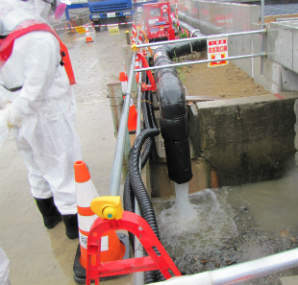
Bypass of clean groundwater around Fukushima Daiichi Nuclear Power Station has started, marking a major milestone in the resolution of water management issues.
First discharge of the clean upstream water stored inside the temporary storage tank started at approximately 10:25 AM and finished at approximately 12:42 PM for all 561 tons to be discharged today, 21 May.
The groundwater bypass, one of several strategies being employed to reduce the accumulation of contaminated water at the plant, aims to intercept clean groundwater as it flows downhill toward the sea, and reroute it safely around the facility. It is pumped up by a series of 12 wells located uphill of the Fukushima Daiichi plant and then temporarily stored to verify its quality prior to release. Test operation of the system began in April; including groundwater collection in some of the system’s nine tanks.
The water’s quality is monitored regularly by independent third parties (Japan Chemical Analysis Centre and The General Environmental Technos Co Ltd, as well as JAEA) using safety and environmental standards more stringent than those set by Japanese law and a variety of sampling regimes. Release limits include 1 Bq/L or less for Cs-134 and Cs-137, 5 Bq/L or less for gross beta radiation, and 1500 Bq/L or less for tritium. Gamma radiation must be undetected using a germanium semiconductor.
Now it is in full operation, the groundwater bypass is expected to reduce the amount flowing into the building basements by up to 100 tons per day, a reduction of 25 percent. The bypass will help reduce the volume of water that becomes contaminated and then needs to be cleaned and stored on site. This, in turn, is expected to reduce the burdens on the storage facility by slowing the pace of contaminated water accumulation.
Today’s discharge came from only one of the nine 1000t-capacity tanks used for stored water. Water collection began on 9 April and monitoring finished on 15 May. As the tanks are grouped in threes, the next water discharge would be much larger. Having three trains of collection tanks allows for more than one operation to be carried out at the same time; in an extreme example, one set could be collecting water, one set holding water under analysis, and a third set discharging water.
Naohiro Masuda, the president of the Fukushima Daiichi D & D Engineering Company, an in-house entity within TEPCO focusing on the decommissioning at the site said "We would like to express our sincere appreciation to many parties, including Fukushima Prefecture and members of the fishing industry, for their understanding in the operation of the groundwater bypass, which plays an important role among the countermeasures to suppress the increase of contaminated water."
Follow Will Dalrymple on Google+
Photo: Groundwater being pumped into a channel by the Fukushima Port. Courtesy TEPCO.






